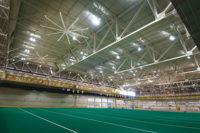In Spain, soccer stadiums are often as beloved as their local teams. So it pays to maintain and upgrade these significant sources of pride and revenue. One such stadium is the Carlos Tartiere in Oviedo. With the city council aiming to repair it, a local architecture engineering firm's use of laser scanning not only precisely identified structural wear, but the scans also revealed previously unknown deformation.
Built in 2001, Oviedo’s Carlos Tartiere stadium is home to the city’s Real Oviedo soccer team, a second-division club that’s been engaging fans for 95 years. As one of the most important clubs in Spain’s northern Asturias region, loyal supporters fill the 30,000-seat venue to near capacity on match days. And as they’ve watched the games, they’ve also witnessed the creeping deterioration of the stadium.
Rectangular in construction, the Carlos Tartiere is made of reinforced concrete that stretches 180 meters long and 100 m wide. Standing at 40-m-high, the structure is topped by a partial, open-air roof comprised of reinforced steel beams covered by a sheet of metal. Over time, water has leaked through small holes around the screws affixing the roof, rusting beams and seats.
As a local government asset, the Oviedo city council recognized the stadium could become a safety risk and issued a call to assess the damage. The council wanted to understand what assets were impacted, to what degree and what solutions they could use to resolve the problem.
Simetría Gestíon, a local architecture engineering firm that specializes in 3D modeling, viewed this as a chance to show the public authority how laser scanning is viable for assessing structural damage. In addition, the 3D imaging could inform a refurbishment plan and long-term maintenance program.
Simetría engineers Víctor Nicieza and Eduardo Alonso took their Trimble X7 scanner to the stadium in November 2020 to capture one upper area that covers three seating sections where the structure had weathered significantly.
 A view of the 44 numbered X7 scanning set ups in the stadium, including the five just under the roof.
A view of the 44 numbered X7 scanning set ups in the stadium, including the five just under the roof.Setting up the X7 for their first scan, they used the X7’s Perspective field software to tie into three existing control points to correctly position the point cloud. They then scanned their way from the field to the upper seating rows to collect every visible feature of the structure. Each time they moved to a new position, the X7 automatically leveled and calibrated itself and the Perspective software automatically registered each scan, allowing the team to review each one in 3D before moving on.
The team completed 44 set-ups in total, including five from a narrow platform just below the roof; in five hours they captured 753 individual roof beams and 80 million 3D points.
“Two of the biggest benefits of the X7 are its self-leveling and automatic scan registration,” said Nicieza. “The ability to set it down and start scanning in seconds, automatically register the scan and then check it right there saves us hours in the field. And it ensures we capture all the features we need the first time.”
 Simetría Gestíon engineer Víctor Nicieza with the Trimble X7 on the field of the Carlos Tartiere stadium.
Simetría Gestíon engineer Víctor Nicieza with the Trimble X7 on the field of the Carlos Tartiere stadium.
After refining and coloring the data in Perspective, they imported it into RealWorks software to create a point cloud accurate to 3mm. They then produced a 3D, color-coded model of the structure, naming every single beam and matching the position of each to the point cloud. Through this exercise, they identified 140 roof beams that need some level of attention, be it painting or full replacement. They also discovered signs of deformation––an unwelcome surprise.
Nicieza and Alonso presented the point cloud, photos and model to the city council, showing precisely which beams are rusted and where they are, and pointed out the deformation.
“With 3D laser scanning, we could show them exactly how much damage there is, which is measurable and calculable,” said Nicieza. “They understood how this information could help them develop a specific refurbishment plan based on only what needs to be repaired. That’s very valuable.”
Based on the helpful information, the council is planning to develop a “digital twin” of the stadium, which will require a precise as-built 3D model. Having proven the precision, speed and cost value of laser scanning, Simetría is waiting to “suit up” for the survey game.







